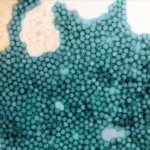Lien vers Pubmed [PMID] – 24280508
Med Sci (Paris) 2013 Nov;29(11):1034-41
The oral poliovaccine, a live vaccine made of attenuated poliovirus strains, is the main tool of the vaccination campaigns organised for eradicating poliomyelitis. these campaigns had led to the decline and, thereafter, to the disappearance of wild poliovirus strains of the three serotypes (1-3) in most parts of the world. However, when the poliovaccine coverage becomes too low, vaccine polioviruses can circulate in insufficiently immunized populations and become then pathogenic by mutations and genetic recombination with other enteroviruses of the same species, in particular some coxsackievirus A. These mutated and recombinant vaccine strains have been implicated in several epidemics of paralytic poliomyelitis. Two polio outbreaks associated with these pathogenic circulating vaccine-derived poliovirus (cVDPV) occurred in 2001-2002 and 2005 in the South of Madagascar where vaccine coverage was low. These cVDPV, of serotype 2 or 3, were isolated from paralyzed children and some of their healthy contacts. Other cVDPV were isolated in the same region from healthy children in 2011, indicating that these viruses were circulating again. Vaccination campaigns could stop the outbreaks in 2002 and 2005, and most probably prevent another one in 2011. Therefore, the genetic plasticity of poliovaccine strains that threatens the benefit of vaccination campaigns is the target of an accurate surveillance and an important theme of studies in the virology laboratories of the Institut Pasteur international network.
